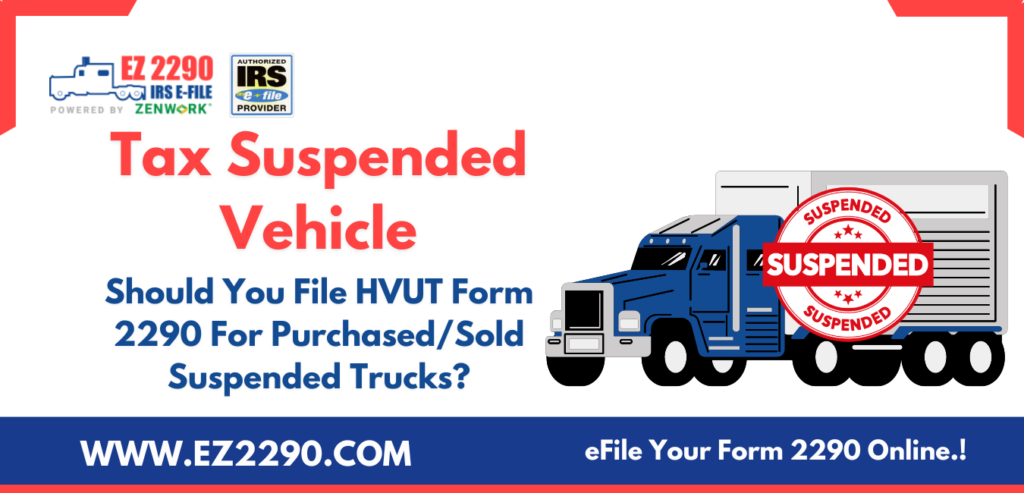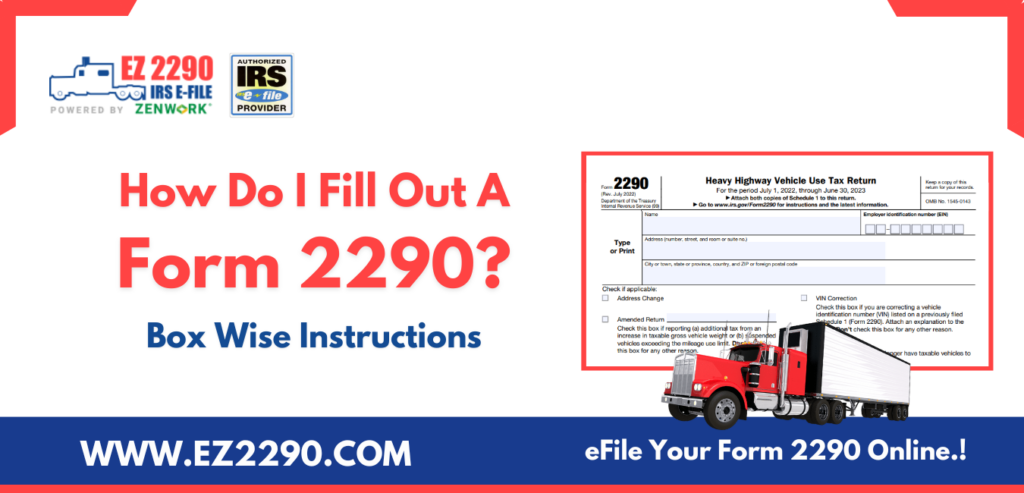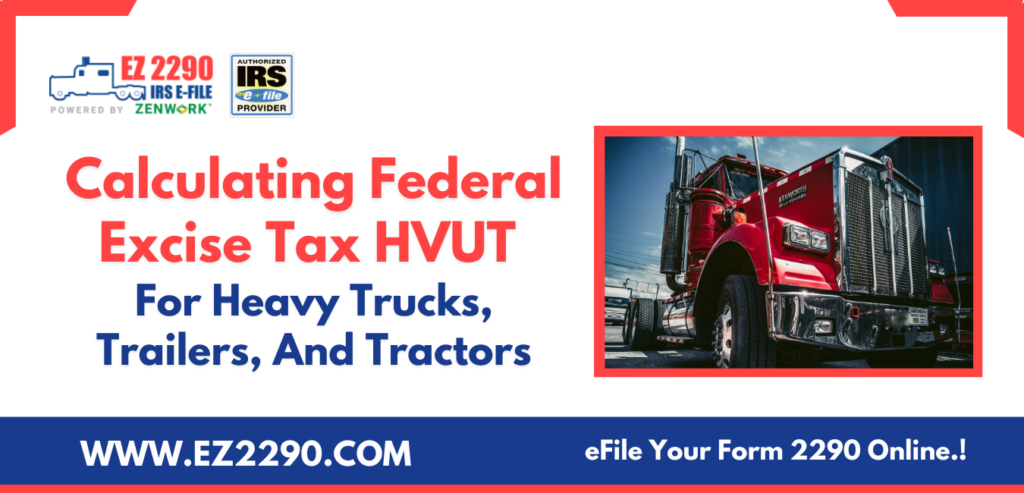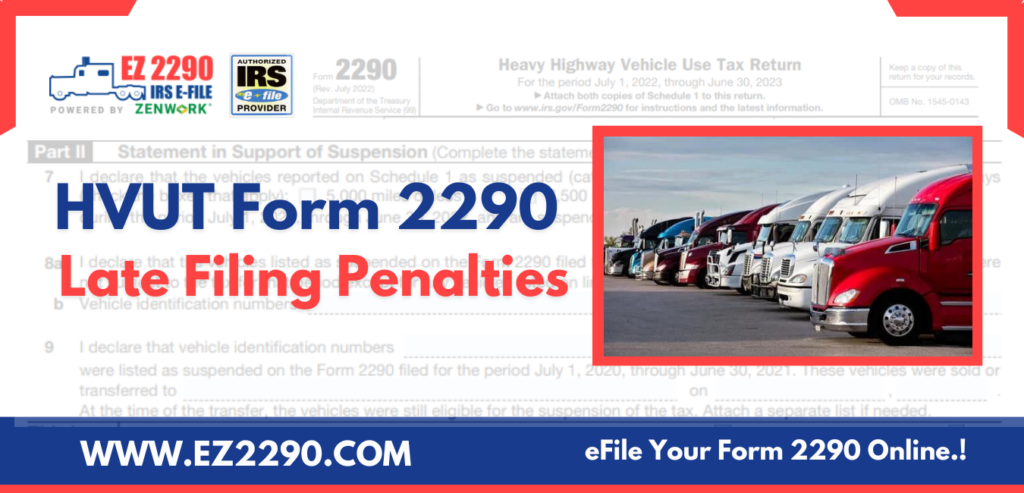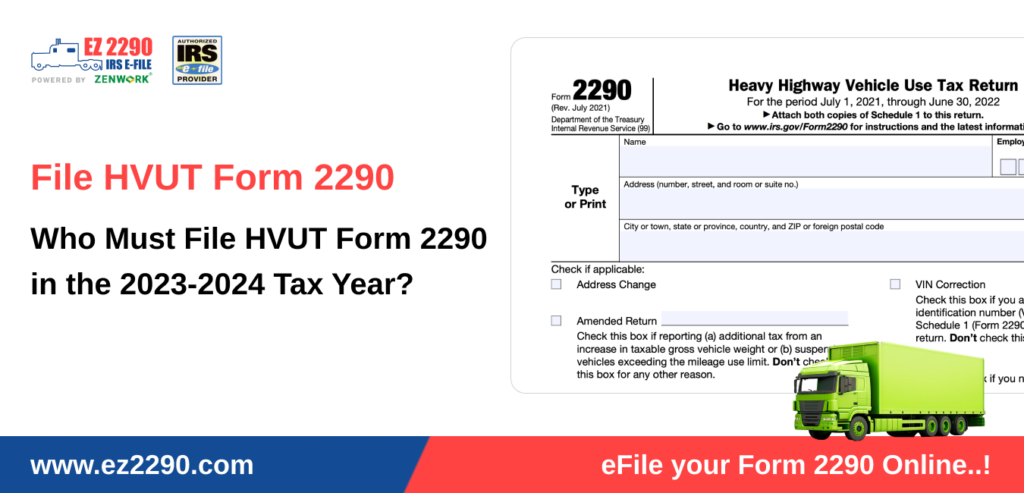
Different types of vehicles that require HVUT Form 2290
The following types of vehicles are subject to the HVUT Form 2290 tax:
- Heavy Trucks: Any vehicle with a gross weight of 55,000 pounds or more is subject to the HVUT tax. This includes heavy-duty trucks used for hauling cargo or other commercial purposes.
- Buses: Buses used for commercial purposes, such as public transportation or charter services, are subject to the HVUT tax if their gross weight is 55,000 pounds or more.
- Trailers and Semi-Trailers: Trailers and semi-trailers customarily attached to vehicles with a gross weight of 55,000 pounds or more are also subject to the HVUT tax.
- Agricultural Vehicles: Certain vehicles used exclusively for agricultural purposes may be exempt from the HVUT tax if their gross weight is 55,000 pounds or more. However, these vehicles must still file HVUT Form 2290 to claim the exemption.
It’s important to note that the gross weight includes the vehicle’s weight, any trailers or semi-trailers, and the maximum load weight specified by the manufacturer. If vehicles meet the weight criteria and are used on public highways, they must file the HVUT Form 2290 and pay the appropriate taxes.
eFile HVUT Form 2290 For 2023-24 Tax Year
Exemptions From Filing the HUVT Form
There are several exemptions from filing the HVUT Form 2290:
- Light Vehicles: Vehicles with a gross weight of less than 55,000 pounds are not subject to the HVUT tax. If your vehicle weighs less than 55,000 pounds, you must not file the HVUT Form 2290 or pay the tax.
- Agricultural Vehicles: Certain vehicles used exclusively for agricultural purposes may be exempt from the HVUT tax if their gross weight is 55,000 pounds or more. To qualify for this exemption, the vehicle must be registered under the owner’s name or the entity that operates it, and it must be used exclusively for farming purposes.
This includes vehicles transporting agricultural products, livestock, or machinery to or from a farm. However, these vehicles must still file HVUT Form 2290 to claim the exemption.
- Logging Vehicles: Vehicles used exclusively for transporting harvested forest products are exempt from the HVUT tax. To qualify for this exemption, the vehicle must be registered under the owner’s name or the entity that operates it, and it must be used exclusively for logging purposes.
- Government Vehicles: Vehicles owned and operated by the federal government, state governments, local governments, or Indian tribal governments are exempt from the HVUT tax. This includes vehicles used for military purposes, public safety, or other government operations.
- Blood Collector Vehicles: Vehicles used by blood collector organizations are exempt from the HVUT tax if used exclusively for blood collection. To qualify for this exemption, the vehicle must be registered under the name of the blood collector organization, and it must not be used for any other purpose.
- Mobile Machinery: Vehicles not designed for transportation on public highways, such as cranes or well-drilling equipment, are exempt from the HVUT tax. To qualify for this exemption, the vehicle must be used exclusively for its intended purpose and not for transportation on public highways.
It’s important to note that even if a vehicle is exempt from the HVUT tax, it may still be required to file the HVUT Form 2290 to claim the exemption. Additionally, if a vehicle is used for a non-exempt purpose during the tax period, the owner or operator must file the HVUT Form 2290 and pay the appropriate taxes.
When to file HVUT Form 2290?
The HVUT Form 2290 must be filed annually by the owner or operator of any taxable vehicle with a gross weight of 55,000 pounds or more. The tax year for HVUT Form 2290 runs from July 1st to June 30th of the following year.
For the 2023-2024 tax year, the HVUT Form 2290 can be filed starting from July 1, 2023. The deadline to file 2290 form and pay any taxes owed is August 31, 2023.
If a new vehicle is in service during the tax year, the HVUT Form 2290 must be filed by the last day of the month following the month the vehicle was first used. For example, if a new vehicle is in service on September 15, the HVUT Form 2290 must be filed by October 31.
File HVUT Form 2290 Online For 2023-24
eFile Form 2290 With The IRS Authorized e-Filing Provider Ez2290
When filing your HVUT Form 2290, choosing the right e-filing provider is crucial for a stress-free and streamlined experience. Ez2290 is an IRS-authorized e-filing provider that offers a range of features and benefits to make e-filing your HVUT Form 2290 as easy and convenient as possible. Here are some reasons why you should consider e-Filing your HVUT Form 2290 with Ez2290:
- Free VIN Correction: If you make a mistake entering the Vehicle Identification Number (VIN) on your HVUT Form 2290, it can lead to delays in processing and potentially even penalties. With Ez2290, you can make unlimited VIN corrections for free.
- Automatic Tax Calculations: Ez2290’s e-Filing system automatically calculates the tax owed based on your vehicle’s weight and other factors, so you don’t have to worry about doing the calculations yourself.
- Bulk Upload Feature: If you have multiple vehicles to file for, Ez2290 offers a bulk upload feature that allows you to upload all your vehicle information simultaneously, saving you time and effort.
- Bank-Grade Security: Your sensitive information is protected by Ez2290’s bank-grade security measures, so you can rest assured that your data is safe.
- Penalty Prevention: If you file your HVUT Form 2290 late or make errors, you may be subject to penalties and interest charges. Ez2290’s e-filing system helps prevent these penalties by filing your form accurately and on time.
In addition to these features, Ez2290 offers 24/7 customer support to answer any questions about the e-filing process. With these benefits and more, Ez2290 is a top choice for anyone looking to e-file their HVUT Form 2290 quickly, easily, and securely.
What is HVUT Form 2290?
The Heavy Vehicle Use Tax (HVUT) Form 2290 is a tax form used by the Internal Revenue Service (IRS) to collect taxes on heavy vehicles operating on public highways. The tax applies to vehicles with a taxable gross weight of 55,000 pounds or more and is calculated based on the vehicle’s weight and mileage.
The HVUT is an annual tax that truck owners must pay, and the funds collected are used to maintain and improve the country’s highways and infrastructure. Truck owners must file HVUT Form 2290 correctly and on time to avoid form 2290 penalties and comply with IRS regulations.
How To Determine The Taxable Weight of Your Vehicle?
To determine the taxable weight of your vehicle for HVUT Form 2290 purposes, you will need to know the following information:
- The unloaded (empty) weight of the truck, trailer, and semi-trailer.
- The weight of any trailers or semi-trailers customarily attached to the vehicle.
- The manufacturer specifies the maximum load weight that the vehicle can carry.
To calculate the taxable weight, add the unloaded weight of the vehicle, the weight of any trailers or semi-trailers customarily attached to the vehicle, and the maximum load weight.
If the total weight is 55,000 pounds or more, the vehicle is subject to the HVUT tax. If the total weight is less than 55,000 pounds, then the vehicle is not subject to the HVUT tax.
eFile 2023-24 Form 2290 & Get Schedule 1
How is The Tax Rate Calculated?
The tax rate for HVUT Form 2290 is based on the vehicle’s taxable gross weight and the month in which the vehicle was first used during the tax period. For most vehicles, the tax rate is $22 per 1,000 pounds of taxable gross weight, up to a maximum of $550 per year. For vehicles that were used for less than a full year, the tax rate is prorated based on the number of months the vehicle was used.
For vehicles considered “suspended” or exempt from the tax, such as those used for agricultural purposes or driven less than 5,000 miles per year, the tax rate is $0. However, these vehicles must still file the HVUT Form 2290 to claim the exemption.
Who Must File HVUT Form 2290 in the 2023-2024 Tax Year?
The filing requirements for the HVUT Form 2290 for the 2023-2024 tax year remain the same as in previous years. Any individual or business that owns and operates a heavy vehicle with a taxable gross weight of 55,000 pounds or more on public highways during the tax period, which runs from July 1, 2023, to June 30, 2024, must file the HVUT Form 2290 and pay the appropriate taxes. This includes trucking companies, owner-operators, and other businesses that use heavy vehicles for commercial purposes.
In addition, if a heavy vehicle was registered in your name during the tax period, but you didn’t operate the vehicle, you still must file HVUT Form 2290 and pay the taxes.
It’s important to note that if you acquire a heavy vehicle during the tax period, you must file HVUT Form 2290 and pay the taxes by the last day of the month after the vehicle was first used.
Different types of vehicles that require HVUT Form 2290
The following types of vehicles are subject to the HVUT Form 2290 tax:
- Heavy Trucks: Any vehicle with a gross weight of 55,000 pounds or more is subject to the HVUT tax. This includes heavy-duty trucks used for hauling cargo or other commercial purposes.
- Buses: Buses used for commercial purposes, such as public transportation or charter services, are subject to the HVUT tax if their gross weight is 55,000 pounds or more.
- Trailers and Semi-Trailers: Trailers and semi-trailers customarily attached to vehicles with a gross weight of 55,000 pounds or more are also subject to the HVUT tax.
- Agricultural Vehicles: Certain vehicles used exclusively for agricultural purposes may be exempt from the HVUT tax if their gross weight is 55,000 pounds or more. However, these vehicles must still file HVUT Form 2290 to claim the exemption.
It’s important to note that the gross weight includes the vehicle’s weight, any trailers or semi-trailers, and the maximum load weight specified by the manufacturer. If vehicles meet the weight criteria and are used on public highways, they must file the HVUT Form 2290 and pay the appropriate taxes.
eFile HVUT Form 2290 For 2023-24 Tax Year
Exemptions From Filing the HUVT Form
There are several exemptions from filing the HVUT Form 2290:
- Light Vehicles: Vehicles with a gross weight of less than 55,000 pounds are not subject to the HVUT tax. If your vehicle weighs less than 55,000 pounds, you must not file the HVUT Form 2290 or pay the tax.
- Agricultural Vehicles: Certain vehicles used exclusively for agricultural purposes may be exempt from the HVUT tax if their gross weight is 55,000 pounds or more. To qualify for this exemption, the vehicle must be registered under the owner’s name or the entity that operates it, and it must be used exclusively for farming purposes.
This includes vehicles transporting agricultural products, livestock, or machinery to or from a farm. However, these vehicles must still file HVUT Form 2290 to claim the exemption.
- Logging Vehicles: Vehicles used exclusively for transporting harvested forest products are exempt from the HVUT tax. To qualify for this exemption, the vehicle must be registered under the owner’s name or the entity that operates it, and it must be used exclusively for logging purposes.
- Government Vehicles: Vehicles owned and operated by the federal government, state governments, local governments, or Indian tribal governments are exempt from the HVUT tax. This includes vehicles used for military purposes, public safety, or other government operations.
- Blood Collector Vehicles: Vehicles used by blood collector organizations are exempt from the HVUT tax if used exclusively for blood collection. To qualify for this exemption, the vehicle must be registered under the name of the blood collector organization, and it must not be used for any other purpose.
- Mobile Machinery: Vehicles not designed for transportation on public highways, such as cranes or well-drilling equipment, are exempt from the HVUT tax. To qualify for this exemption, the vehicle must be used exclusively for its intended purpose and not for transportation on public highways.
It’s important to note that even if a vehicle is exempt from the HVUT tax, it may still be required to file the HVUT Form 2290 to claim the exemption. Additionally, if a vehicle is used for a non-exempt purpose during the tax period, the owner or operator must file the HVUT Form 2290 and pay the appropriate taxes.
When to file HVUT Form 2290?
The HVUT Form 2290 must be filed annually by the owner or operator of any taxable vehicle with a gross weight of 55,000 pounds or more. The tax year for HVUT Form 2290 runs from July 1st to June 30th of the following year.
For the 2023-2024 tax year, the HVUT Form 2290 can be filed starting from July 1, 2023. The deadline to file 2290 form and pay any taxes owed is August 31, 2023.
If a new vehicle is in service during the tax year, the HVUT Form 2290 must be filed by the last day of the month following the month the vehicle was first used. For example, if a new vehicle is in service on September 15, the HVUT Form 2290 must be filed by October 31.
File HVUT Form 2290 Online For 2023-24
eFile Form 2290 With The IRS Authorized e-Filing Provider Ez2290
When filing your HVUT Form 2290, choosing the right e-filing provider is crucial for a stress-free and streamlined experience. Ez2290 is an IRS-authorized e-filing provider that offers a range of features and benefits to make e-filing your HVUT Form 2290 as easy and convenient as possible. Here are some reasons why you should consider e-Filing your HVUT Form 2290 with Ez2290:
- Free VIN Correction: If you make a mistake entering the Vehicle Identification Number (VIN) on your HVUT Form 2290, it can lead to delays in processing and potentially even penalties. With Ez2290, you can make unlimited VIN corrections for free.
- Automatic Tax Calculations: Ez2290’s e-Filing system automatically calculates the tax owed based on your vehicle’s weight and other factors, so you don’t have to worry about doing the calculations yourself.
- Bulk Upload Feature: If you have multiple vehicles to file for, Ez2290 offers a bulk upload feature that allows you to upload all your vehicle information simultaneously, saving you time and effort.
- Bank-Grade Security: Your sensitive information is protected by Ez2290’s bank-grade security measures, so you can rest assured that your data is safe.
- Penalty Prevention: If you file your HVUT Form 2290 late or make errors, you may be subject to penalties and interest charges. Ez2290’s e-filing system helps prevent these penalties by filing your form accurately and on time.
In addition to these features, Ez2290 offers 24/7 customer support to answer any questions about the e-filing process. With these benefits and more, Ez2290 is a top choice for anyone looking to e-file their HVUT Form 2290 quickly, easily, and securely.
If you own a commercial truck, you may be required to file HVUT Form 2290 for the 2023-2024 tax year. Failure to file or pay late can result in penalties, so it’s important to understand who must file, when, and how to file correctly. This blog will guide you through the process and provide helpful tips to ensure compliance with IRS regulations.

As a commercial truck owner, you have a lot of responsibilities to keep your business running smoothly. One important aspect of truck ownership is understanding and complying with tax regulations, such as the HVUT Form 2290.
This form is used to report and pay taxes on heavy vehicles operating on public highways, and failure to file or pay late can result in significant penalties.
To help you navigate the filing process for the 2023-2024 tax year, we’ve compiled this guide to answer the question, “Who Must File HVUT Form 2290?”
In this blog, we’ll explain the filing requirements, deadlines, and payment options, so you can stay compliant and avoid costly mistakes.
What is HVUT Form 2290?
The Heavy Vehicle Use Tax (HVUT) Form 2290 is a tax form used by the Internal Revenue Service (IRS) to collect taxes on heavy vehicles operating on public highways. The tax applies to vehicles with a taxable gross weight of 55,000 pounds or more and is calculated based on the vehicle’s weight and mileage.
The HVUT is an annual tax that truck owners must pay, and the funds collected are used to maintain and improve the country’s highways and infrastructure. Truck owners must file HVUT Form 2290 correctly and on time to avoid form 2290 penalties and comply with IRS regulations.
How To Determine The Taxable Weight of Your Vehicle?
To determine the taxable weight of your vehicle for HVUT Form 2290 purposes, you will need to know the following information:
- The unloaded (empty) weight of the truck, trailer, and semi-trailer.
- The weight of any trailers or semi-trailers customarily attached to the vehicle.
- The manufacturer specifies the maximum load weight that the vehicle can carry.
To calculate the taxable weight, add the unloaded weight of the vehicle, the weight of any trailers or semi-trailers customarily attached to the vehicle, and the maximum load weight.
If the total weight is 55,000 pounds or more, the vehicle is subject to the HVUT tax. If the total weight is less than 55,000 pounds, then the vehicle is not subject to the HVUT tax.
eFile 2023-24 Form 2290 & Get Schedule 1
How is The Tax Rate Calculated?
The tax rate for HVUT Form 2290 is based on the vehicle’s taxable gross weight and the month in which the vehicle was first used during the tax period. For most vehicles, the tax rate is $22 per 1,000 pounds of taxable gross weight, up to a maximum of $550 per year. For vehicles that were used for less than a full year, the tax rate is prorated based on the number of months the vehicle was used.
For vehicles considered “suspended” or exempt from the tax, such as those used for agricultural purposes or driven less than 5,000 miles per year, the tax rate is $0. However, these vehicles must still file the HVUT Form 2290 to claim the exemption.
Who Must File HVUT Form 2290 in the 2023-2024 Tax Year?
The filing requirements for the HVUT Form 2290 for the 2023-2024 tax year remain the same as in previous years. Any individual or business that owns and operates a heavy vehicle with a taxable gross weight of 55,000 pounds or more on public highways during the tax period, which runs from July 1, 2023, to June 30, 2024, must file the HVUT Form 2290 and pay the appropriate taxes. This includes trucking companies, owner-operators, and other businesses that use heavy vehicles for commercial purposes.
In addition, if a heavy vehicle was registered in your name during the tax period, but you didn’t operate the vehicle, you still must file HVUT Form 2290 and pay the taxes.
It’s important to note that if you acquire a heavy vehicle during the tax period, you must file HVUT Form 2290 and pay the taxes by the last day of the month after the vehicle was first used.
Different types of vehicles that require HVUT Form 2290
The following types of vehicles are subject to the HVUT Form 2290 tax:
- Heavy Trucks: Any vehicle with a gross weight of 55,000 pounds or more is subject to the HVUT tax. This includes heavy-duty trucks used for hauling cargo or other commercial purposes.
- Buses: Buses used for commercial purposes, such as public transportation or charter services, are subject to the HVUT tax if their gross weight is 55,000 pounds or more.
- Trailers and Semi-Trailers: Trailers and semi-trailers customarily attached to vehicles with a gross weight of 55,000 pounds or more are also subject to the HVUT tax.
- Agricultural Vehicles: Certain vehicles used exclusively for agricultural purposes may be exempt from the HVUT tax if their gross weight is 55,000 pounds or more. However, these vehicles must still file HVUT Form 2290 to claim the exemption.
It’s important to note that the gross weight includes the vehicle’s weight, any trailers or semi-trailers, and the maximum load weight specified by the manufacturer. If vehicles meet the weight criteria and are used on public highways, they must file the HVUT Form 2290 and pay the appropriate taxes.
eFile HVUT Form 2290 For 2023-24 Tax Year
Exemptions From Filing the HUVT Form
There are several exemptions from filing the HVUT Form 2290:
- Light Vehicles: Vehicles with a gross weight of less than 55,000 pounds are not subject to the HVUT tax. If your vehicle weighs less than 55,000 pounds, you must not file the HVUT Form 2290 or pay the tax.
- Agricultural Vehicles: Certain vehicles used exclusively for agricultural purposes may be exempt from the HVUT tax if their gross weight is 55,000 pounds or more. To qualify for this exemption, the vehicle must be registered under the owner’s name or the entity that operates it, and it must be used exclusively for farming purposes.
This includes vehicles transporting agricultural products, livestock, or machinery to or from a farm. However, these vehicles must still file HVUT Form 2290 to claim the exemption.
- Logging Vehicles: Vehicles used exclusively for transporting harvested forest products are exempt from the HVUT tax. To qualify for this exemption, the vehicle must be registered under the owner’s name or the entity that operates it, and it must be used exclusively for logging purposes.
- Government Vehicles: Vehicles owned and operated by the federal government, state governments, local governments, or Indian tribal governments are exempt from the HVUT tax. This includes vehicles used for military purposes, public safety, or other government operations.
- Blood Collector Vehicles: Vehicles used by blood collector organizations are exempt from the HVUT tax if used exclusively for blood collection. To qualify for this exemption, the vehicle must be registered under the name of the blood collector organization, and it must not be used for any other purpose.
- Mobile Machinery: Vehicles not designed for transportation on public highways, such as cranes or well-drilling equipment, are exempt from the HVUT tax. To qualify for this exemption, the vehicle must be used exclusively for its intended purpose and not for transportation on public highways.
It’s important to note that even if a vehicle is exempt from the HVUT tax, it may still be required to file the HVUT Form 2290 to claim the exemption. Additionally, if a vehicle is used for a non-exempt purpose during the tax period, the owner or operator must file the HVUT Form 2290 and pay the appropriate taxes.
When to file HVUT Form 2290?
The HVUT Form 2290 must be filed annually by the owner or operator of any taxable vehicle with a gross weight of 55,000 pounds or more. The tax year for HVUT Form 2290 runs from July 1st to June 30th of the following year.
For the 2023-2024 tax year, the HVUT Form 2290 can be filed starting from July 1, 2023. The deadline to file 2290 form and pay any taxes owed is August 31, 2023.
If a new vehicle is in service during the tax year, the HVUT Form 2290 must be filed by the last day of the month following the month the vehicle was first used. For example, if a new vehicle is in service on September 15, the HVUT Form 2290 must be filed by October 31.
File HVUT Form 2290 Online For 2023-24
eFile Form 2290 With The IRS Authorized e-Filing Provider Ez2290
When filing your HVUT Form 2290, choosing the right e-filing provider is crucial for a stress-free and streamlined experience. Ez2290 is an IRS-authorized e-filing provider that offers a range of features and benefits to make e-filing your HVUT Form 2290 as easy and convenient as possible. Here are some reasons why you should consider e-Filing your HVUT Form 2290 with Ez2290:
- Free VIN Correction: If you make a mistake entering the Vehicle Identification Number (VIN) on your HVUT Form 2290, it can lead to delays in processing and potentially even penalties. With Ez2290, you can make unlimited VIN corrections for free.
- Automatic Tax Calculations: Ez2290’s e-Filing system automatically calculates the tax owed based on your vehicle’s weight and other factors, so you don’t have to worry about doing the calculations yourself.
- Bulk Upload Feature: If you have multiple vehicles to file for, Ez2290 offers a bulk upload feature that allows you to upload all your vehicle information simultaneously, saving you time and effort.
- Bank-Grade Security: Your sensitive information is protected by Ez2290’s bank-grade security measures, so you can rest assured that your data is safe.
- Penalty Prevention: If you file your HVUT Form 2290 late or make errors, you may be subject to penalties and interest charges. Ez2290’s e-filing system helps prevent these penalties by filing your form accurately and on time.
In addition to these features, Ez2290 offers 24/7 customer support to answer any questions about the e-filing process. With these benefits and more, Ez2290 is a top choice for anyone looking to e-file their HVUT Form 2290 quickly, easily, and securely.




